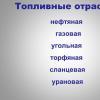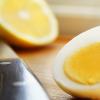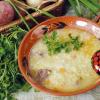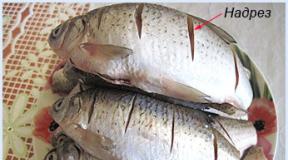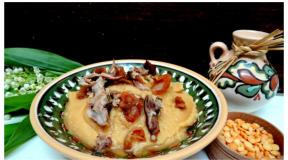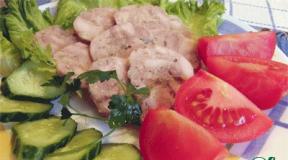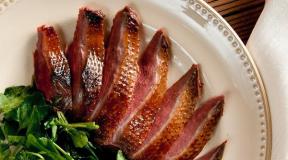Birch bark processing technologies. Tool. Types of decorative processing of birch bark and types of birch bark products
It is best to harvest birch bark in the spring. The best birch bark is smooth, with a beautiful pattern (narrow stripes) - from one of the most common varieties of birch - downy birch. This birch grows over most of our country. A peculiar feature of the downy birch, which makes it easy to distinguish it from another type of birch, the warty birch, is the small, dense fluff that covers the young shoots and leaves. Downy birch forms the second layer in pine or sparse spruce forests, and is found in low-lying and floodplain areas that are flooded with water in the spring.
The strongest and densest birch bark is produced by birches grown on dry and rocky soils. And trees growing in peat bogs and swamps have brittle bark, with knots, and an uneven, corroded surface.
The tool for removing birch bark is an ordinary sharp knife. For the products offered in this chapter, birch bark is removed in layers and with tape. To harvest layered birch bark, horizontal cuts are made on the birch trunk; to harvest bast tape, spiral cuts are made around the trunk. If you need large, solid pieces, then birch bark should be removed from cut trees with a diameter of at least 20 cm, if possible choosing places that are smooth and without knots.
The entire outer (white) side of the bark is cleaned with a knife or sandpaper and freed from dirt and fungi and moss growing on the birch. The inner side is freed from the remains of porous, brown birch bark and wiped with a damp cloth. Such thick birch bark is also suitable for large products. For small ones, thick birch bark is steamed and separated into two or three layers simply by hand, without additional tools. This work must be done carefully, without rushing. Young and freshly cut birch bark does not need to be steamed, but only slightly moistened.
Birch bark removed by any of the above methods must be dried and kept in a dry, dark and cool place for preservation. It is better to store large plastic birch bark under a load, stacking the layers on top of each other.

Birch bark layers are well colored with aniline dyes. First, tannins are extracted from birch bark. To do this, soak it in a soap solution or baking soda solution. And then the birch bark is placed in a hot solution with dye for 2-3 hours, depending on the intended tone. To dry, the painted birch bark is hung on a string, hooked onto the tip of the sheet with simple paper clips or clothespins. Don't wait for it to dry completely, remove it a little earlier - it's better to work with slightly damp birch bark. If you need to straighten birch bark, then thin layers can simply be ironed.
The color of unpainted birch bark is also very beautiful if it is coated with colorless alcohol varnish. To do this, you need to slightly warm up the varnish and apply it to the birch bark with a soft hair brush.
They cut along birch bark with the tip of a very well sharpened knife, a razor or scissors. In places where there are curves, you should use small scissors with rounded ends, and for cutting holes, on the contrary, with sharp ends or a knife. Repeating circles can be punched with a punch.

In order for the birch bark to be better attached to the chosen base, for example, to thick cardboard or to another piece of birch bark, you need to glue thin paper to the underside (inner) side of the birch bark and only then cut out the design. You need to glue it with liquid wood glue or PVA. If you use PVA glue, then it is advisable to then iron the glued birch bark through thick paper with a not very hot iron.
In any case, the glued product or its parts should be placed under a press for some time to be leveled in order to prevent possible twisting and deformation.
The work took
4th place

I live in the Komi Republic - this is a rich and beautiful northern region. In the east of the republic stretch the ancient Ural Mountains, in the very north there is the mountain tundra. Komi land is endless forests, generous waters and rich mineral resources, cozy cities and villages. Hardworking, talented people live here, among whom there are Masters with golden hands. They create a variety of traditional artistic products that continue to preserve and transmit the memory of our ancestors. In many regions of the republic, traditional folk crafts and arts crafts based on manual labor and descended from grandfathers and great-grandfathers have been preserved. The greatest development has been achieved in artistic processing and wood carving, weaving from birch bark, wicker, pine root, traditional wood painting, patterned knitting and weaving, fur processing, various types of women's needlework - patchwork, embroidery, lace making, etc.
All these crafts undoubtedly deserve special attention, but to complete my course (and now competition) work, I settled on studying the birch bark craft... About it a little later, but first I will tell and show you how I made my “birch bark” tuesok )))))

To do this, we will need a white landscape paper (it will be the background, but you can do without it if you make the tuesok as a separate element for future compositions), office paper in pastel colors (light yellow, mustard, brown), scissors, a simple pencil , glue, brown marker (felt-tip pen, pencil or paint, depending on what you are more used to working with)))))

We draw a sketch of our tueska on light paper...

We cut out the template itself and additional parts from mustard paper - the upper and lower rim, as well as the handle... If desired, you can immediately punch holes in the rims - through which we will “sew together” our spare parts)))))

We glue all the parts together, use wax chalk (pencil, marker) to make light strokes that imitate the pattern on birch bark... I sprinkled some more brown pencil crumbs on top and shaded it with vertical movements, now our birch bark has become even more like the real one)) )))

Now we pass a “birch bark” cord through the holes, simply cut the light paper into small strips, round one edge, glue them over the holes... The tuesok is almost ready... In this version, it also has the right to exist, but we will not rest on this and decorate it with some kind of patterns - in my case it will be Komi ornaments...

Using a simple pencil we mark out a simple ornament...

Next, we draw out our ornament with paints, markers or pencils and now the piece is finally ready!!! It turned out very similar, it seems to me... You can safely proceed to the next stage - processing real birch bark))))))

And now a little about the craft itself... Since ancient times, birch bark has attracted the attention of folk craftsmen because during processing it retained its properties - softness, flexibility and strength. Birch bark is the top thin layer of birch bark of a delicate pinkish-cream color. Its ancient name “birch bark” has been known since the 15th-16th centuries. Later, “birch bark” and “birch bark” appeared. These names are still used today. Tuesa (buraks) - vessels for storing food and drink - were made from birch bark before and are now being made. When leaving to work in the field, the peasant took with him a container of water or kvass, and on the hottest day the drink in the container remained cold. On his back he wore a birch bark - a wicker backpack, and on his feet were bast shoes, often woven from birch bark. Bodies, birch bark boxes - boxes for flour and honey, baskets, shepherd's horns, ropes for fishing gear - all this was made from birch bark. Based on the nature of the ornament, northern carved birch bark can be divided into several types associated with other areas of folk art - embroidery and bone carving.

Manufacturing technology. Birch bark is harvested at the beginning of summer, at the end of May - June, when the birch tree is full of juices, and the birch bark easily lags behind the rest of the bark. If it was removed skillfully, without damaging the next layer of bark - the green, then it did not harm the tree, and after a few years elegant white clothes grew on it again. The first known information about the technology of processing birch bark dates back to the 18th century. Birch bark carving requires the simplest tools: a knife and an awl. First, the outline of the design is drawn, which is then cut out with a sharp knife. Carving and embossing on birch bark were sometimes combined with shotting. By hitting the kanfarnik (a tube-shaped embossing) with a hammer, the craftsman “selects” the background of the object and obtains a grainy surface. This technique has long been known in metal processing. Since the 19th century, it has also been used in birch bark products.

Products made from birch bark were painted with picturesque plant patterns. As a rule, craftsmen filled the surface of the products with floral patterns (a thin winding stem with leaves and branches, smooth curves). Craftsmen usually applied through, openwork “lace” (carving) from birch bark onto a bright background made of fabric, foil or paper, which made it possible to achieve a high decorative effect. Birch bark tues (buraks) are more often ornamented. The process of making tues itself is quite complicated: you need to carefully remove the bark from the tree without damaging it. This will be the inside of the tues. It is solid, even water will not leak out of it. The chips on the front side are wrapped in a “shirt”, i.e. birch bark, cut on one side. The shirt is slightly smaller and has a “lock” closure. Then a wooden bottom is hammered into the steamed hammer, wrapped in a shirt. A lid with a handle is cut out from above. Tues is ready. The master, at his own discretion and in accordance with the tradition existing in the area, before covering the cleavage with a shirt, can decorate it with a geometric or zoomorphic (image of animals) ornament. Sometimes the shirt of the tues is cut out with a floral ornament or a geometric pattern.

And in conclusion, I would like to say that despite the fact that art is constantly developing, more and more advanced technologies are constantly layered on top of old ones, old forms are used more and more whimsically, birch bark production remains almost unchanged... Of course, in souvenir shops you can find birch bark objects with some modern heroes, but this is more the exception than the rule... Basically, the craftsmen adhere to traditional methods of making birch bark products, they pass on their skills and experience from generation to generation, so this craft has survived to this day almost in its original form. And I’ll finish here and thank everyone for your attention!!!
Sources of information: website of the All-Russian public organization "Russian Geographical Society" and the official website of the Ministry of Culture of the Komi Republic.
Birch bark is best processed immediately after removal. First of all, you clean off the black growths. By careful rubbing with a cloth you remove the white layer from the surface. If you need thin birch bark, you immediately stratify it, because later it hardens and the procedure becomes difficult. When delaminating, it is best to hold it across the fibers, then it is easier to give in and does not tear. In the old days, birch bark was processed in a special way, and birch bark became elastic, like rovduga, and durable. I will give three ways to process birch bark:
- 1. Having thoroughly cleaned, processed, rubbed with fat or warm oil until completely absorbed. Horse fat is especially good for this purpose. Birch bark becomes soft, pliable for a needle or awl.
- 2. Cook birch bark in the ear. Birch bark becomes much stronger. The birch bark boiled in the ear was used to make a boat. The famous sturgeon glue was made from the swim bladder of the sturgeon. The broth of fish soup gives birch bark special strength, this has long been known to our ancestors.
- 3. Birch bark is heated in skim milk diluted with water and this gives elasticity and softness.
- 4. Stale dry birch bark is kept in warm water or steamed hot water. Birch bark becomes soft.
The processed birch bark, tightly rolled up with the outer side, was stored in a dark and cool place: a milk cellar, in a manger under the rumps. The birch bark was rolled into a tube along the grain; in this case, when making vessels, the edges were not bent and the walls were not wrinkled.
When storing a large supply of birch bark for urasa, it is laid in layers crosswise, pressed down with a heavy log and covered with all sorts of rubbish - garbage.
Having cut the birch bark into layers, it is kept in the shade. When the birch bark begins to curl, roll it into rolls, sequentially winding the layers with the light side out. In this case, you should make the ends of the layers, pressing the bottom layer with the top layer so that they do not curl when drying.
Having wound 8-10 layers into a roll (the number depends on the length), it is wrapped in paper and tied with twine or wire.
Harvesting birch bark from dead trees. In the forest, you can often find fallen birch trees, whose wood has rotted, but the birch bark remains intact, or dead birch trees damaged by the fungus - tinder fungus. In such trees, birch bark is easily separated at any time of the year. Its inner layer has various shades of red-brown and is used to decorate products.
Safety precautions - When in the forest, you must be extremely careful. You cannot appear on the plot during deforestation - this is very dangerous. Collective trips to harvest birch bark are carried out only under the guidance of a teacher. You must have a first aid kit with you to provide first aid.
Birch bark storage.
To work with birch bark, prepare a blunt and sharp knife, scissors, a dry rag and sunflower oil. Birch bark is laid out on the table, preferably in the fresh air in the shade; where it dries.
Do not unroll the roll completely. First, take one layer, wipe it with a dry cloth and place it on the table with the white side up. Birch bark needs to be divided into several layers; First, the top rough white layer is separated. The layers are removed using a blunt knife with an oval end or by hand.
If the birch bark is thin, taken from young birch trees or from the upper part of the trunk, it is not stratified into layers. Such birch can be braided on both sides - on the white and dark sides, all thickenings and sagging, as well as places where there were knots, are cut out with a knife or scissors. The treated birch bark is dried in the shade in separate layers. At the same time, it should not dry out, otherwise the material will become hard and brittle. It is no longer possible to work with such birch bark. When the birch bark layers begin to curl slightly, they are collected into rolls, after wiping them with a cloth soaked in sunflower oil.
All that remains is to sort the birch bark by color, wrap it in paper and indicate on it what color the birch bark is and the date it was harvested. In a cool, dark room or in a pantry at room temperature, birch bark can be stored for years. In a damp room, birch bark becomes covered with mold and stains. Poorly dried material also cannot be stored for long. To prevent birch bark from losing its softness, elasticity and natural color, you should periodically check whether it is dry or damp.
If you find stains of dampness on the birch bark, you need to carefully check the room, then dry it and wipe it from the wrong side with a cloth moistened with sunflower oil.
Soak the dried birch bark in warm water or hold it over steam. After which all operations are repeated, as when harvesting from wood - drying and rolling.
Birch bark for elegant, artistic products must be stored especially carefully. For this purpose, a cool, dry, dark room is required. When exposed to sunlight, birch bark changes color after 3-4 days and becomes reddish. Birch bark turns white from prolonged exposure to light. Any change in color is accompanied by a loss of strength, flexibility and extensibility.
For storage, birch bark is folded into bundles and placed between two boards, pressing them with a weight on top.
Nowadays, birch bark can be folded under a press of thick boards, bolted together and stored in a dark and damp place. Birch bark preserved in this way becomes smooth, like cardboard or thick paper, and is convenient for making any utensils. Birch bark intended for gluing and painting is not impregnated with oil or grease and is stored in its original form. Oil gives birch bark a certain color and prevents it from sticking together.
Organization of the workplace - The room should have natural and electric lighting, running water, a storage room for storing materials, a low table and a chair. birch bark product birch bark Yakut
Safety precautions and fire prevention - birch bark is a highly flammable material, so the use of open fire near its storage is prohibited. The main causes of fire are smoking in an unspecified place, the use of open fire indoors, increasing the rules for operating electrical appliances, including the operation of faulty electrical appliances. The workplace must be kept clean. After finishing the birch bark trimming sessions, they take out a special place designated for this. Classrooms, workshops and workplaces must be equipped in accordance with sanitation, hygiene and safety requirements. There is a place on the desktop for tools, but it is better to put them in a special box. A cluttered table or scattered tools can cause injury. A knife, an awl, knives, and a lector cutter should have a smooth oval handle made of hardwood. When sharpening knives, special care must be taken (12-15-16-17-19)
Birch bark can be prepared not at any time, but only during the period of sap flow. The timing of birch bark harvesting differs slightly in different geographical zones, on average it is mid-May to mid-July. The earlier spring comes, the earlier the harvesting time. People who deal with birch bark have a sure sign: when the dandelions begin to fluff up and the rose hips begin to bloom, it’s time to harvest the material. At this time, the birch leaves are already gaining strength, but birch sap cannot be obtained. Later, the birch bark grows to the bast and it becomes impossible to separate it. Harvesting is carried out in forests where planned tree felling is planned. Everything must first be agreed upon with forestry representatives. For preparations, you need to choose a sunny day without precipitation. So, the harvesting begins with an inspection of the birch. Select trees with a more or less smooth trunk, with a minimum number of knots and without scabs.
Birch bark is very decorative in fallen and slightly rotten birch trees. You can remove the birch bark from them at any time without problems.
Make a vertical cut in the bark with a jamb knife to the depth of the birch bark layer (1-2mm) to the bast (this is the bottom layer of birch bark) and two horizontal notches on top and bottom of the cut:
Then you need to pry the edge of the birch bark layer and begin to carefully remove it

If the timing is chosen correctly, the birch bark literally separates itself from the tree

In places where the birch bark grows to the bast with knots, carefully trim it with a knife. Birch trees with a lot of knots and warts should be avoided

Birch bark brought from the forest must be dried. To do this, lay it out under a canopy in 1 layer with the wrong side (white side) down. I dry birch bark in the attic.

After the birch bark has completely dried, the layers are folded into bundles so that the birch bark is “face” to “face” and the bundle is pressed using sticks and ropes

How to prepare birch bark. Preparation of birch bark. For a knife handle made of birch bark with your own hands.
There is practically no ideal birch bark. Therefore, you have to use a knife to remove all the unevenness and roughness from the outer (white) side of the birch bark.

Birch bark for winter.
For a knife handle made of birch bark with your own hands.
I use birch bark in small squares from old birch trees. It is thicker, each birch bark tree has its own color. At home, we clean off excess dirt and residues under the birch bark layer from both sides of the birch bark. Cut into rectangles across and along the black veins. We drill or cut through the center and use the template. Then we put alternating light and dark birch bark on the centering pin, and alternate rectangles with the direction of the veins. Be sure to lubricate the clamp plate with oil, otherwise you won’t be able to tear off the birch bark later.


The central pin must be taken without a thread, otherwise the whole thing will have to be driven along the thread to be removed.

We tighten the clamp as much as possible but delicately, otherwise the pin will burst



We boil for 20-30 minutes, or longer, but then the birch bark will begin to darken. We take out the whole thing and put it on hot. repeat the procedure 2-3 times

Then I dry it for 4 days. Those tar oils that were released during cooking and pressing will glue the birch bark together better than any glue; they can’t be broken apart only along the layers of birch bark, and even then with difficulty. Then I unscrew the clamp, take out the central pin on the grinding section and process the edges of the workpiece.

The layers are pressed so that even if there are dark veins on the birch bark, after pressing in this way they will disappear. Therefore, you can take birch bark from very old birch trees.

I installed this kind of workpiece for non-through installation and it still works and doesn’t even think it’s delaminating. It is as strong as wood.





